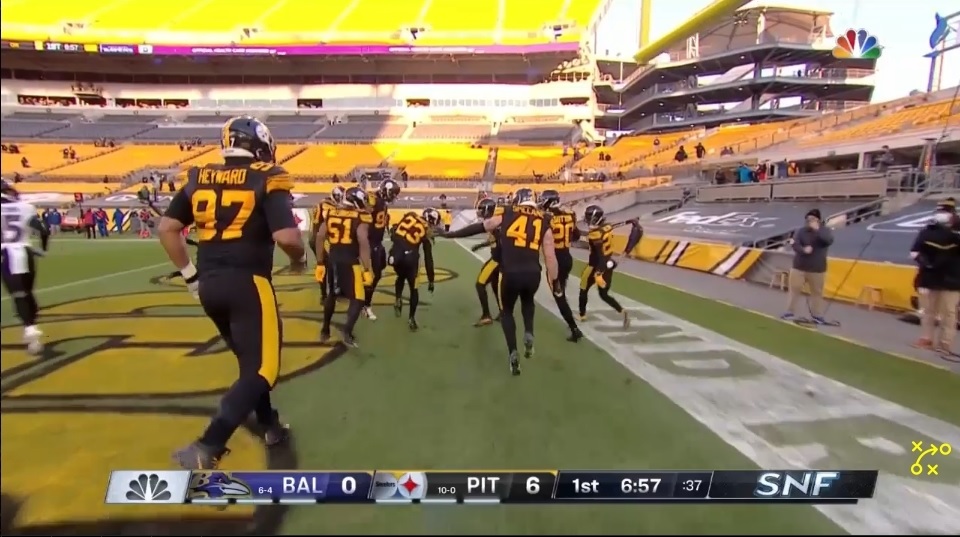For the final time of 2020, a look at the Pittsburgh Steelers’ defense from a charting/tracking perspective. We’re now able to go through our weekly defensive charting from the entire season and provide you data below. Unless otherwise stated, this information is for the regular season only. Not the Wild Card loss.
If you have any questions about data not shared below, feel free to ask in the comments.
Excluding no-plays and kneeldowns, the defense was on the field for 992 regular season snaps. Here’s how that stacks up year-by-year.
2020: 992
2019: 1067
2018: 1021
2017: 979
2016: 1040
2015: 1102
Second lowest of the last six seasons. Only higher than 2017’s 979. A better offense cut about 70 snaps down from a season ago.
– The all-important personnel grouping info.
Nickel: 39.2% (389 snaps)
3-4: 36.6% (363 snaps)
Dime: 17.9% (178 snaps)
3-5: 2.9% (29 snaps)
Amoeba: 2.3% (23 snaps)
Goal Line: 0.9% (9 snaps)
4-4: 0.1% (1 snap)
– Nickel narrowly edges out base for the most used personnel grouping of the season. For as much as we talk about the death of base 3-4, it was used well over two-thirds of the time. Dime usage didn’t occur as much this year, though a little of that has to do with the loss of Devin Bush and general injuries at ILB. Didn’t have a “guy” to trust in dime packages the back half of the year.
– My usual disclaimer. Those are just the broad groupings. You can break things down a lot more. Here’s how you can categorize their 3-4.
3-4 Base: 62.8% (228 snaps)
3-4 Over: 18.5% (67 snaps)
3-4 Nickel: 12.4% (45 snaps)
3-4 Over/Nickel: 5.5% (20 snaps)
3-4 Big: 0.3% (1 snap)
3-4 Off: 0.3% (1 snap)
3-4 Off/Nickel: 0.3% (1 snap)
– Another run through on what those terms mean. Base is your traditional 3-4 front. “Over” is the front shifted to the strength of the formation. This was done 59.8% of the time against multiple TE sets, excluding empty formations. Their “nickel” front is when a third CB replaced Terrell Edmunds. Their “big” front was used just once, a three safety/one CB grouping. And the “off” was a unique set with Cam Heyward playing something closer to a standup linebacker position.
– Overall, here’s the split between base and sub-package defense. This excludes goal line and their 4-4 front (which doesn’t feel like it falls into either bucket), giving us 982 snaps to evaluate.
Sub-package: 60.1%
Base: 39.9%
Sub vs base numbers since 2015.
2019:
Sub: 68.5%
Base: 31.3%
2018:
Sub: 68.4%
Base: 31%
2017:
Sub: 61.1%
Base: 38.8%
2016:
Sub: 70.5%
Base: 28.7%
2015:
Sub: 71.3%
Base: 27.4%
– Pittsburgh’s base defense usage this season was the highest its been since 2015. That grouping isn’t dead. Not when it’s basically used 40% of the time. Getting creative with different groupings out of 3-4, like playing with a third corner, have been ways the defense has attempted to blend run defense vs coverage.
– Keith Butler’s (Mike Tomlin’s?) final blitz rate of 2020 came in at 35.6%. That’s down slightly from our last mid-season check. Here are his yearly blitz percentages:
2014: 28%
2015: 33.3%
2016: 39.7%
2017: 33.2%
2018: 44.1%
2019: 33.5%
2020: 35.6%
Up a little bit from last year but just about average relative to other seasons.
Here’s his weekly blitz rate from 2020.
Week 1 vs NYG: 52.7%
Week 2 vs DEN: 41.7%
Week 3 vs HOU: 21.9%
Week 5 vs PHI: 34.1%
Week 6 vs CLE: 29.0%
Week 7 vs TEN: 19.4%
Week 8 vs BAL: 34.3%
Week 9 vs DAL: 46.3%
Week 10 vs CIN: 27.9%
Week 11 vs JAC: 46.3%
Week 12 vs BAL: 22.7%
Week 13 vs WSH: 22.9%
Week 14 vs BUF: 62.0%
Week 15 vs CIN: 31.3%
Week 16 vs IND: 28.2%
Week 17 vs CLE: 31.4%
– Let’s look at Keith Butler’s 5+ rush rate from this season. It came in at 38.9%. Here’s how that stacks up year-by-year.
2015: 33.6%
2016: 27.7%
2017: 19.5%
2018: 36%
2019: 34.3%
2020: 38.9%
A new high for Butler and this Steelers’ defense. Some of that could be attributed due to Pittsburgh playing more base this year than any year before but also a focus on dropping TJ Watt and Bud Dupree less often in coverage.
– Let’s check things out by position group.
Pressures
Stephon Tuitt: 33
Cam Heyward: 32
Tyson Alualu: 9
Chris Wormley: 8
Henry Mondeaux: 2
Isaiah Buggs: 1
Carlos Davis: 0
Snaps Per Pressure
Lower the number, the better.
Wormley: 9
Tuitt: 14.4
Heyward: 15.1
Mondeaux: 19
Alualu: 24.8
Buggs: 57
– Very strong numbers for Tuitt and Heyward. Tuitt’s pressure numbers are actually slightly worse than last years (12.7) but his sacks skyrocketed. Able to finish the play more often.
– Overall YPC numbers leave out a lot of context but quick stat for you as it relates to run defense. Steelers’ run defense with Cam Heyward on the field allowed 3.9 YPC. Steelers’ run defense with Cam Heyward off the field allowed 4.8 YPC. Almost a full yard difference.
– Isaiah Buggs played 105 snaps the first half of the season. Only 16 the rest of the year. Team clearly didn’t like what they saw.
Linebacker
Pressures
TJ Watt: 53
Bud Dupree: 32
Alex Highsmith: 15
Vince Williams: 7
Robert Spillane: 4
Devin Bush: 4
Avery Williamson: 3
Marcus Allen: 3
Ola Adeniyi: 1
Jay Elliott: 1
Cassius Marsh: 0
Snaps Per Pressure
Again, lower the number, the better.
Williams: 6.9
Williamson: 7.3
Spillane: 8.0
Watt: 8.7
Dupree: 10.6
Elliott: 11
Highsmith: 13.9
Adeniyi: 72
You can see what makes the Steelers ILB blitzes so effective. Three ILBs with the best snap/pressure numbers. But those are often by design to free those guys up. Watt’s snap/pressure rate continues to improve. Yearly numbers.
2017: 9.6
2018: 12.0
2019: 11.1
2020: 8.7
Dupree also set a career high.
– Coverage rates for the OLBs.
Dupree: 8.6%
Watt: 9.4%
Highsmith: 11.9%
Adeniyi: 12.1%
Marsh: 14.3%
Elliott: 42.1%
Here are Watt and Dupree’s drop rates season-by-season.
Watt:
2020: 9.4%
2019: 9.1%
2018: 19.3%
2017: 37.3%
Dupree:
2020: 8.6%
2019: 7.8%
2018: 18.3%
2017: 24.7%
2016: 27.3%
2015: 12.3%
Rates have settled in the last two seasons. For these guys, under 10% is where I want them to be.
– Target data for the LBs.
Marcus Allen: 3/3 5 yards, 0 TDs 0 INTs
Alex Highsmith: 2/5 21 yards, 0 TDs 1 INT
TJ Watt: 1/8 20 yards, 1 TD 1 INT
Devin Bush: 6/12 70 yards, 1 TD 0 INTs
Avery Williamson: 9/12 80 yards, 2 TDs 0 INTs
Robert Spillane: 9/16 99 yards, 0 TDs 1 INT
Vince Williams: 15/20 181 yards, 4 TDs 0 INTs
– QB rating against.
Highsmith: 13.3
Watt: 39.6
Spillane: 48.7
Allen: 79.2
Bush: 95.8
Williamson: 131.9
Williams: 141.9
Some small sample sizes to consider here. Williamson and Williams hard larger target shares and with good reason. Struggled in coverage.
Secondary
– Coverage numbers for the DBs.
Antoine Brooks Jr.: 0/1 0 yards 0 TDs 0 INT
James Pierre: 1/1 -1 yards 0 TDs 0 INTs
Sean Davis: 1/2 10 yards 0 TDs 0 INTs
Justin Layne: 3/5 43 yards 0 TDs 0 INTs
Mike Hilton: 10/25 129 yards 0 TDs 3 INTs
Minkah Fitzpatrick: 9/28 121 yards 1 TD 3 INTs
Cam Sutton: 23/40 290 yards 1 TD 1 INT
Terrell Edmunds: 17/37 243 yards 1 TD 2 INTs
Steven Nelson: 26/51 267 yards 5 TDs 2 INTs
Joe Haden: 32/61 508 yards 3 TDs 2 INTs
– QB rating against.
Hilton: 17.3
Fitzpatrick: 19.2
Edmunds: 54.2
Sutton: 78.1
Nelson: 82.7
Haden: 83.2
Layne: 87.9
Hilton and Fitzpatrick have elite QB ratings in the regular season. It was just one game but their struggles in the playoffs were evident. Here are their numbers from that game.
Mike Hilton: 2/2 66 yards, 1 TD 0 INTs (158.3 QB rating against)
Minkah Fitzpatrick: 2/2 15 yards, 1 TD 0 INTs (137.5 QB rating against)
– Despite missing time with a shoulder injury, Mike Hilton blitzed 57 times this season. He registered eight pressures, a rate of one pressure every 7.1 tries.







